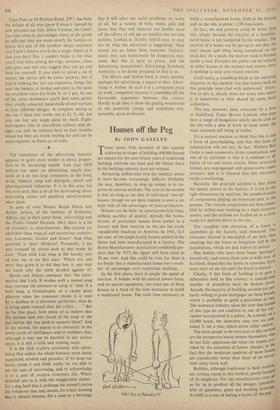Houses off the Peg
By JOHN GASELEE
THERE seems little prospect of this country achieving its target of building 400,000 houses per annum for the next twenty years if traditional building methods are used and the labour force in the building industry does not expand.
Attracting skilled men into the industry seems to have become increasingly difficult. Probably the way, therefore, to step up output is to im- prove on current methods. The root of the trouble is that we cling to the idea of individual 'one-off' houses, though we are quite content to own a car built with all the advantages of mass production.
Houses can be built on mass-production lines, without sacrifice of quality. Already the manu- facture of permanent houses from timber in a factory and their erection on the site has made considerable headway in America. In 1961, 16.5 per cent. of the single-family houses erected in the States had been manufactured in a factory. The Home Manufacturers Association confidently pre- dicts that by 1975 the figure will have risen to 50 per cent, And this could be true, for there is no doubt that a manufactured house has a num- ber of advantages over traditional building.
In the first place, there is simply the speed of erection. A builder with his normal labour force, and no special equipment, can erect one of these houses in a third of the time necessary to build a traditional house. The total time necessary to 'Oh! Go to Paradise!!' build a manufactured house, both in the factory and on the site, is about 1,250 man-hours.
In fact, the real position could be better than this, simply because the erection of a manufac- tured house is not hampered by the weather. The exterior of a house can be put up in one day, the roof trusses and tiling being completed on the third day. As a result, the interior work is finished under a roof. Provided the public can be induced to order houses in the autumn and winter, there is nothing to stop year-round erection.
Until lately, a stumbling-block to the universal adoption of this method was that houses built on this principle were clad with cedarwood. Attrac- tive as this is, clearly there are many sites where it is unsuitable—a view shared by some local authorities.
This has, however, been overcome by a firm at Guildford, Cedar Homes Limited, who now have a range of bungalows which can be clad on the site with a skin of brick or local stone, the main structure still being of timber.
It's a natural reaction to think that this is just a form of jerry-building, and that this form of construction will not last. In fact, Western Red
Cedar is used extensively in the construction, and one of its attributes is that it is resistant to all forms of rot and insect attacks. Other structural
timbers are impregnated with preservative under pressure, and it is claimed that this treatment really is everlasting.
Basically, the principle adopted is that when the timber arrives at the factory, it is cut to the right dimensions by machine, the standardisation of components playing an important part in the process. The various components are then assem- bled by skilled men working on a team incentive system, and the sections are loaded on to a lorry ready for delivery direct to the site.
The complete side elevation of a house is assembled in the factory, and measured. The tolerance allowed is one-eighth of an inch, thus ensuring that the house or bungalow will fit the foundations, which are laid before its arrival. , One builder who buys these house 'packages extensively, and erects them over a wide area of Scotland, dispatches his teams in caravans. Each team stays on the site until the house is erected.
Clearly, if this form of building is to gain a substantial hold in this country, a considerable number of prejudices must be broken down' Already the majority of building societies are per- fectly willing to grant mortgages on these houses' which is probably as good a guarantee as arlY. The insurance industry takes the view that houses of this type do not conform to one of the war- ranties incorporated in a policy. As a result, on a £3,000 house, the insurance may cost an addi- tional 7s. 6d. a year, which seems rather absurd.
,
The main people to be won over to this method are the prospective house-owners themselves, `oho do not fully appreciate the value for money Pro- vided by the reduction of labour charges, or the fact that the insulation qualities of these houses are considerably better than those of an eleven' inch cavity brick wall. Builders, although traditional in their outlook; are coming round to this method, partly because of its simplicity. For the manufacturers even go so far as to produce all the designs, schedules, bills of quantities, plans and working drawings' It really is a case of buying a house off the peg.






































 Previous page
Previous page